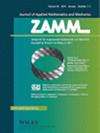Turbulent heat and mass lines in finite difference regime
IF 3.2
4区 工程技术
Q1 MATHEMATICS, APPLIED
Zamm-zeitschrift Fur Angewandte Mathematik Und Mechanik
Pub Date : 2023-10-14
DOI:10.1002/zamm.202300093
引用次数: 0
Abstract
Abstract Finite difference modelling of turbulent heat and mass flow visualization finds numerous applications in atmospheric flows/oceanic currents, wind turbines, thermal transfer in nuclear reactors, drag in oil pipelines, cooling of industrial machineries, and to investigate the complexity, dynamic and chaotic nature of the physical system. A turbulent phenomenon is effectively implemented in engineering, physics, earth sciences, bio‐engineering and medicine. Hence, motivated by the advantages of turbulence in various engineering fields, in the current article, a finite difference analysis is performed to demonstrate the k‐ε turbulence model‐based heat and mass lines visualization in boundary layer regime under turbulent buoyancy‐driven convective conditions along a cylinder. Turbulent flow characteristics are accurately explored by deploying the classical Newtonian flow model. Further, to accomplish a more sophisticated finite difference simulation, the effects of extra kinetic energy and its dissipation rate equations are considered. The produced Navier‐Stokes equations for time‐dependent turbulent heat and mass transmission are rendered to non‐dimensional by deploying suitable dimensionless numbers. The advanced coupled nonlinear turbulent unsteady buoyancy‐motivated vertical convection problem is then solved with a well‐sophisticated finite difference scheme such as Crank‐Nicolson technique using computational software. Authentication of current results with former solutions over a range of buoyancy number, Schmidt, and Prandtl parameters are presented. An extensive tabular and graphical discussion along with contours, heat and masslines visualization is included to enumerate the hydro‐dynamic, thermal and mass diffusion behaviour for the impact of emerged regulating numbers in the Prandtl regime. It is confirmed that, the accelerating turbulent buoyancy‐ratio number, maximizes the velocity, kinetic energy and dissipation rate at . Further, the numerical values of laminar thermal and mass diffusion rates are monotonically enhanced when compared to the turbulent values. Also, to verify the current findings, the authors compared the LRN k‐ε model turbulent results with the existing solutions and found good agreement. Further, the uniqueness and novelty of the current investigation is the exploration of heat and masslines in unsteady buoyancy‐driven convection regime under the influence of k‐ε turbulence model which extends the former studies and offers a more precise appraisal of the thermal and mass diffusion lines via the Crank‐Nicolson analysis.有限差分状态下的湍流热和质量线
摘要湍流热流和质量流可视化的有限差分建模在大气流动/洋流、风力涡轮机、核反应堆的传热、石油管道的阻力、工业机械的冷却以及研究物理系统的复杂性、动态性和混沌性方面有着广泛的应用。湍流现象在工程、物理、地球科学、生物工程和医学中得到了有效的应用。因此,考虑到湍流在各个工程领域的优势,本文采用有限差分分析的方法,演示了在湍流浮力驱动的圆柱对流条件下,基于k - ε湍流模型的边界层热质量线可视化。采用经典的牛顿流动模型,精确地探讨了湍流的流动特性。此外,为了完成更复杂的有限差分模拟,考虑了额外动能及其耗散率方程的影响。通过部署合适的无量纲数,生成的随时间变化的湍流热和质量传递的Navier - Stokes方程呈现为无量纲。先进的耦合非线性湍流非定常浮力驱动的垂直对流问题,然后解决了一个非常复杂的有限差分格式,如曲克-尼科尔森技术使用计算软件。在浮力数、施密特和普朗特参数的范围内,对现有结果进行了验证。广泛的表格和图形讨论以及等高线,热和质量线可视化包括列举在普朗特尔制度中出现的调节数的影响的流体动力学,热和质量扩散行为。结果表明,加速湍流浮力比数使速度、动能和耗散率达到最大。此外,与湍流数值相比,层流热扩散率和质量扩散率的数值单调增大。此外,为了验证目前的发现,作者将LRN k‐ε模型的湍流结果与现有的解进行了比较,发现了很好的一致性。此外,当前研究的独特性和新颖性在于在k‐ε湍流模型的影响下探索非定常浮力驱动对流状态下的热量和质量线,该模型扩展了以前的研究,并通过曲克‐尼科尔森分析提供了更精确的热量和质量扩散线评估。
本文章由计算机程序翻译,如有差异,请以英文原文为准。
求助全文
约1分钟内获得全文
求助全文
来源期刊
CiteScore
3.30
自引率
8.70%
发文量
199
审稿时长
3.0 months
期刊介绍:
ZAMM is one of the oldest journals in the field of applied mathematics and mechanics and is read by scientists all over the world. The aim and scope of ZAMM is the publication of new results and review articles and information on applied mathematics (mainly numerical mathematics and various applications of analysis, in particular numerical aspects of differential and integral equations), on the entire field of theoretical and applied mechanics (solid mechanics, fluid mechanics, thermodynamics). ZAMM is also open to essential contributions on mathematics in industrial applications.

 求助内容:
求助内容: 应助结果提醒方式:
应助结果提醒方式:


